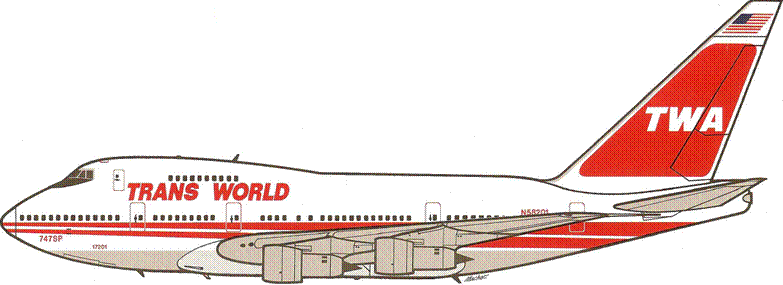More Range
The Need for Non-Stops
Airline passengers as a rule wish to take their journeys without the inconvenience of having to stop en route. They simply wish to reach their destinations as quickly as possible. Thus, during the best years of the piston-engined era, the airliner manufacturers were able to develop their products so that the Douglas DC-7s and the Lockheed Constellation series could offer first, non-stop transcontinental range in the U. S.A. (about 2,500 miles), then non-stop trans-Atlantic (about 3,500 miles). Later improvements brought non-stop U. S. west coast to Europe, and, in the 1970s, California-Japan.
New York – Tokyo
The Boeing 747 could accomplish all these missions with ease. But Pan American Airways wanted something more: no less than New York to Tokyo non-stop, a distance of 6,754 statute miles, with a full payload. The Boeing Company obliged with a special version of its Jumbo Jet, the Special Performance variant, or the Boeing 747SP. This was achieved by providing extra tankage and more powerful engines, but mainly by shortening the fuselage to lighten the all-up weight.
Pan American opened its New York-Tokyo route on 25 April 1976; but quite surprisingly, the airline world did not rush to Seattle to join the long-range club. Even Japan Air Lines, which would have been expected to react with matching non-stop service, chose not to; and — perhaps wisely— waited for the expected development of the standard 747 series.
Limited Demand
The main reason, however, why the SP did not shake up the procurement patterns (and much to the satisfaction of Douglas, which found difficulty on matching such range with its DC-10s) was because the market was inadequate to justify large fleets of extremely long-ranged airliners. Transport economists and forecasters are acutely aware of the “gravity model” or theory which, in general principle, states—quite reasonably— that the greater the population, the greater the demand. More people, more traffic. But also, the further people are apart from each other, the less they are likely to travel; and this applies to business and leisure travel alike, the influencing factors being mainly time and cost.
The Boeing 747SP was a victim of the gravity theory. Lines drawn on a world map to link big cities that were far apart from each other were found to be optimistic in terms of potential traffic demand, because of the gravity model. Aus
tralia’s population, for example, is less than that of New York or California, so the potential traffic for non-stop routes, although measurable, was not enough to justify an airline fleet. And the traffic across the Atlantic still concentrated on the major destinations in northwest Europe, and did not need Special Performance.
Today, a quarter of a century after the Boeing 747SP opened service, the urban populations all over the world have grown considerably, to bring one element of the gravity model up to acceptance level for fleet forecasting purposes. Southern and eastern Asia, especially, contain many cities, each with more than ten million inhabitants, and with strong commercial travelling requirements. But special versions of the world’s leading airliner types are no longer needed. The basic versions can all fulfill the most demanding ranges required by all the intercontinental airlines.
Were the 747SP to be reintroduced today, the market need would no doubt generate greater sales than in the 1970s. But today’s front-line flagships can all fly ranges sufficient for all the trans-ocean city pairs. The Airbus A340, the Boeing 767, and the Boeing 777 can theoretically encircle the world at the temperate zone latitudes with only one stop.
 |
|
|


![]()

 |
THE EARLY BOEING 747S COMPARED
Trans World Airlines did not join the initial rush to buy the Boeing 747SP. But on 17 October 1978, it ordered 3 aircraft for direct routes to the Middle East. They were operated for only a few years. Aside from the limitations imposed by the gravity theory, the new Boeing 767 was on its way, and the performance and potential of the new generation of this wide-bodied twin airliner usuiped the merits of the SP.
|
|










